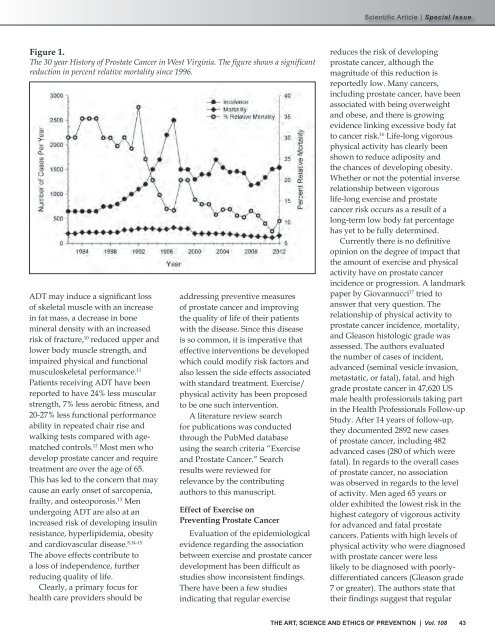Special CME Issue - West Virginia State Medical Association
Special CME Issue - West Virginia State Medical Association
Special CME Issue - West Virginia State Medical Association
Create successful ePaper yourself
Turn your PDF publications into a flip-book with our unique Google optimized e-Paper software.
Figure 1.<br />
The 30 year History of Prostate Cancer in <strong>West</strong> <strong>Virginia</strong>. The figure shows a significant<br />
reduction in percent relative mortality since 1996.<br />
ADT may induce a significant loss<br />
of skeletal muscle with an increase<br />
in fat mass, a decrease in bone<br />
mineral density with an increased<br />
risk of fracture, 10 reduced upper and<br />
lower body muscle strength, and<br />
impaired physical and functional<br />
musculoskeletal performance. 11<br />
Patients receiving ADT have been<br />
reported to have 24% less muscular<br />
strength, 7% less aerobic fitness, and<br />
20-27% less functional performance<br />
ability in repeated chair rise and<br />
walking tests compared with agematched<br />
controls. 12 Most men who<br />
develop prostate cancer and require<br />
treatment are over the age of 65.<br />
This has led to the concern that may<br />
cause an early onset of sarcopenia,<br />
frailty, and osteoporosis. 13 Men<br />
undergoing ADT are also at an<br />
increased risk of developing insulin<br />
resistance, hyperlipidemia, obesity<br />
and cardiovascular disease. 8,14-15<br />
The above effects contribute to<br />
a loss of independence, further<br />
reducing quality of life.<br />
Clearly, a primary focus for<br />
health care providers should be<br />
addressing preventive measures<br />
of prostate cancer and improving<br />
the quality of life of their patients<br />
with the disease. Since this disease<br />
is so common, it is imperative that<br />
effective interventions be developed<br />
which could modify risk factors and<br />
also lessen the side effects associated<br />
with standard treatment. Exercise/<br />
physical activity has been proposed<br />
to be one such intervention.<br />
A literature review search<br />
for publications was conducted<br />
through the PubMed database<br />
using the search criteria “Exercise<br />
and Prostate Cancer.” Search<br />
results were reviewed for<br />
relevance by the contributing<br />
authors to this manuscript.<br />
Effect of Exercise on<br />
Preventing Prostate Cancer<br />
Evaluation of the epidemiological<br />
evidence regarding the association<br />
between exercise and prostate cancer<br />
development has been difficult as<br />
studies show inconsistent findings.<br />
There have been a few studies<br />
indicating that regular exercise<br />
reduces the risk of developing<br />
prostate cancer, although the<br />
magnitude of this reduction is<br />
reportedly low. Many cancers,<br />
including prostate cancer, have been<br />
associated with being overweight<br />
and obese, and there is growing<br />
evidence linking excessive body fat<br />
to cancer risk. 16 Life-long vigorous<br />
physical activity has clearly been<br />
shown to reduce adiposity and<br />
the chances of developing obesity.<br />
Whether or not the potential inverse<br />
relationship between vigorous<br />
life-long exercise and prostate<br />
cancer risk occurs as a result of a<br />
long-term low body fat percentage<br />
has yet to be fully determined.<br />
Currently there is no definitive<br />
opinion on the degree of impact that<br />
the amount of exercise and physical<br />
activity have on prostate cancer<br />
incidence or progression. A landmark<br />
paper by Giovannucci 17 tried to<br />
answer that very question. The<br />
relationship of physical activity to<br />
prostate cancer incidence, mortality,<br />
and Gleason histologic grade was<br />
assessed. The authors evaluated<br />
the number of cases of incident,<br />
advanced (seminal vesicle invasion,<br />
metastatic, or fatal), fatal, and high<br />
grade prostate cancer in 47,620 US<br />
male health professionals taking part<br />
in the Health Professionals Follow-up<br />
Study. After 14 years of follow-up,<br />
they documented 2892 new cases<br />
of prostate cancer, including 482<br />
advanced cases (280 of which were<br />
fatal). In regards to the overall cases<br />
of prostate cancer, no association<br />
was observed in regards to the level<br />
of activity. Men aged 65 years or<br />
older exhibited the lowest risk in the<br />
highest category of vigorous activity<br />
for advanced and fatal prostate<br />
cancers. Patients with high levels of<br />
physical activity who were diagnosed<br />
with prostate cancer were less<br />
likely to be diagnosed with poorlydifferentiated<br />
cancers (Gleason grade<br />
7 or greater). The authors state that<br />
their findings suggest that regular<br />
THE ART, SCIENCE AND ETHICS OF PREVENTION | Vol. 108 43















